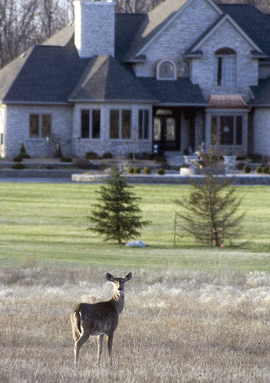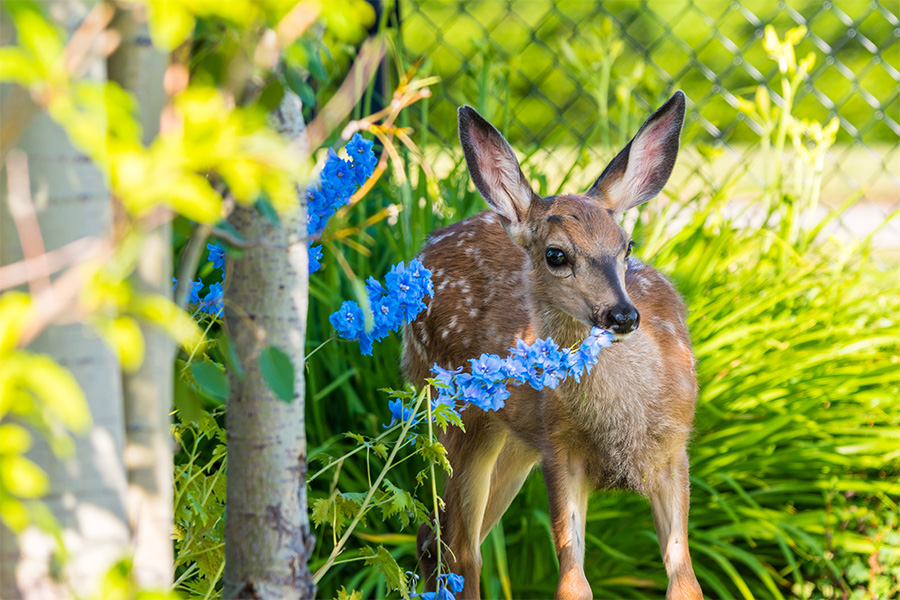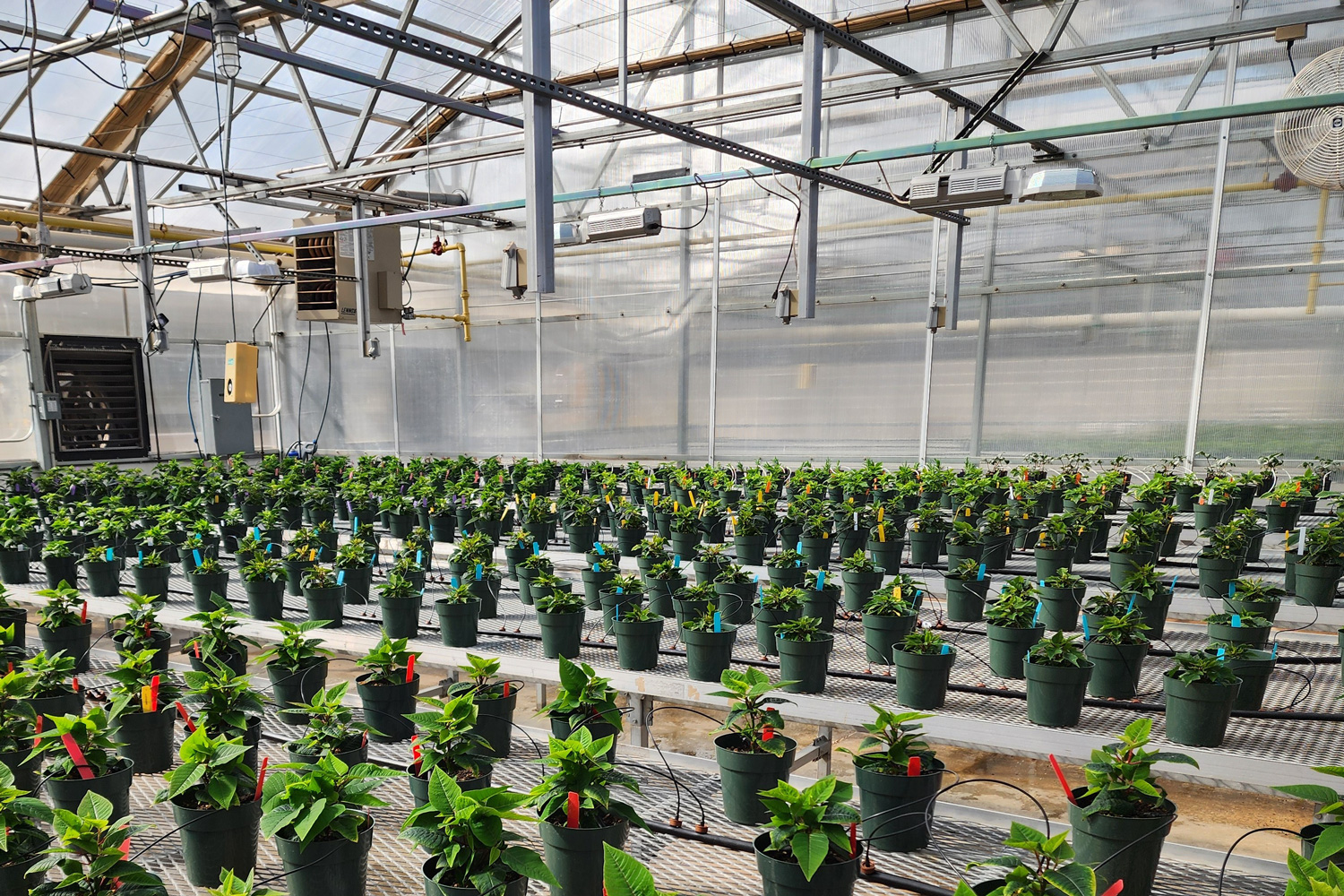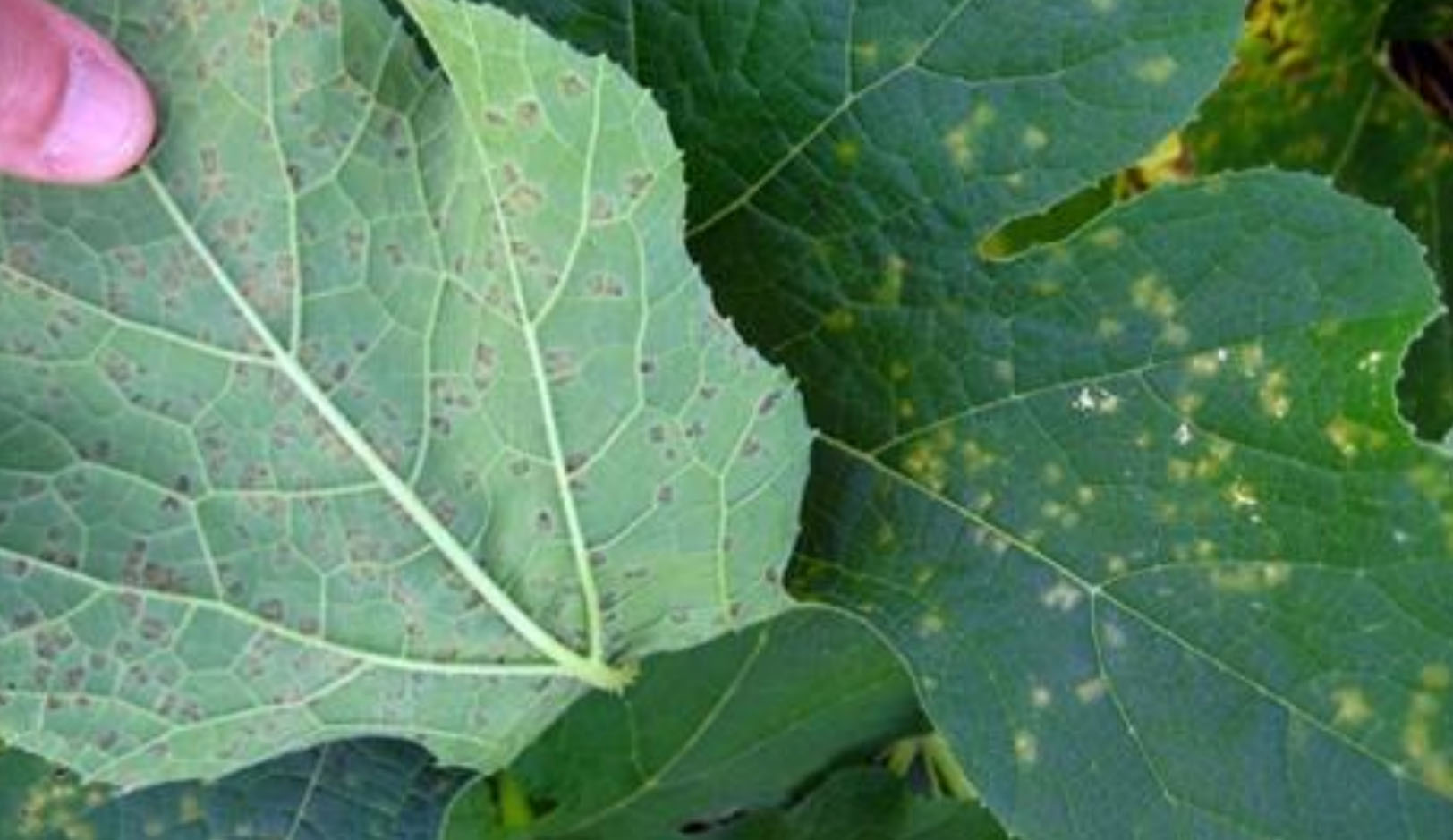
Deer like nutrition-rich plants, especially in spring and summer when does are pregnant or nursing, when young deer are growing and when bucks are growing antlers. Fertilized plants, such as those in home landscapes, provide protein, energy-rich carbohydrates, minerals and salts. Deer also get about one-third of their water from the moisture in irrigated plants and young, succulent vegetation on expanding leaves, buds and green stems.
Nuisance deer that feast on home gardens and bucks that damage young trees by rubbing them with their antlers during the rutting season are difficult and expensive to control in residential communities. Although there are a number of commercially available deer repellents on the market, none of them are 100 percent effective. Most “home remedy” repellents, such as soap, human hair and animal dung, are unreliable. Shooting deer or using noise guns is prohibited in most residential neighborhoods, and many citizens are opposed to this method of control. Fencing whole communities or individual properties is often not practical, and may be against local ordinances or community covenants. Trapping and relocating deer is costly and often harmful or fatal to deer.
If deer are overabundant in your neighborhood, and deer herd reduction or management is not feasible, a good way to prevent deer browsing in landscapes is to plant ornamental plants that deer do not like to eat.
There is no such thing as a deer-resistant plant, and when deer populations are high and food becomes scarce, deer may feed on plants that are thought to be deer-tolerant. However, deer generally do not like plants with pungent aromas. Some gardeners have reported success with planting strong-scented plants like lantana, catmint, chives, mint, sage or thyme adjacent to plants that deer frequently browse. Deer also shy away from plants with prickly or rough leaves and plants with a bitter taste. Sometimes, deer browse new plantings or established plants with tender new growth, then avoid those same plants when their leaves are mature.
Over the years, wildlife organizations, universities, botanical gardens and garden writers have constructed many lists of deer-tolerant and deer-susceptible ornamental plants. Because most of these lists are constructed from observational trial-and-error data instead of controlled scientific studies, they are open for criticism. Furthermore, many variables influence deer feeding preferences.
The list below is a compilation of ornamental plants for Georgia hardiness zones that appear in published literature (see References) as well as observations by the authors. It is intended to be a guide for selecting ornamental plants for landscapes where deer browsing is a problem. Plants known to be invasive and a serious problem in natural areas, regardless of their level of deer tolerance, were excluded from the list.
Plants Deer Occasionally or Frequently Browse
(Protection is recommended)
| Common Name | Botanical Name |
|---|---|
| American Arborvitae | Thuja occidentalis |
| American Beautyberry | Callicarpa acmericana |
| American Elder | Sambucus canadensis |
| American Sycamore | Platanus occidentalis |
| Arrow-wood | Viburnum dentatum |
| Asiatic Lilies | Lilium spp. |
| Beech (low branches) | Fagus spp. |
| Bittersweet | Celastrus scandens |
| Black-Eyed Susan | Rudbeckia spp. |
| Blackgum | Nyssa sylvatica |
| Blanket Flower | Gaillardia spp. |
| Buttonbush | Cephalanthus occidentalis |
| Carolina Ash | Fraxinus caroliniana |
| Carolina Buckthorn | Frangula caroliniana |
| Carolina Yellow Jessamine | Gelsemium sempervirens |
| Chrysanthemum (fall mums) | Chrysanthemum spp. |
| Coleus | Coleus spp. |
| Cosmos | Cosmos spp. |
| Crossvine | Bignonia capreolata |
| Daylily (prefer flowers and flower buds) | Hemerocallis spp. |
| Eastern Redbud | Cercis canadensis |
| Flowering Crabapple (small trees and low branches) | Malus spp. |
| Flowering Dogwood | Cornus florida |
| Fothergilla (flowers and new growth) | Fothergilla spp. |
| Fringetree | Chionanthus virginicus |
| Gerbera Daisy | Gerbera jamesonii |
| Grape Hyacinth | Muscari spp. |
| Green Ash (tender new growth) | Fraxinus pennsylvanica |
| Greenbriar | Smilax spp. |
| Hawthorn | Crataegus spp. |
| Hibiscus | Hibiscus spp. |
| Some Hollies (some, such as Lusterleaf, Mary Nell, Nellie R. Stevens, Blue) | Ilex spp. |
| Hollyhock | Alcea spp. |
| Honey Locust | Gleditsia triacanthos |
| Hop Hornbeam | Ostrya virginiana |
| Hosta | Hosta spp. |
| Hydrangea (bigleaf, oakleaf, climbing) | Hydrangea spp. |
| Impatiens | Impatiens walleriana |
| Indian Hawthorn | Rhaphiolepis indica |
| Japanese Maple (tender new growth) | Acer palmatum |
| Morning Glory | Ipomea spp. |
| Trumpet Honeysuckle | Lonicera sempervirens |
| Pansy | Viola spp. |
| Petunia | Petunia spp. |
| Redbay | Persea borbonia |
| Red Maple | Acer ruburm |
| Rhododendron | Rhododendron spp. |
| Rose Balsam | Impatiens balsamina |
| Roses | Rosa spp. |
| Sedum ‘Autumn Joy’ | Sedum ‘Autumn Joy’ |
| Serviceberry | Amelanchier arborea |
| Soloman’s Seal, | Polygonatum spp. |
| Sourwood (tender new growth) | Oxydendron aroreum |
| Strawberry Bush | Euonymus ameicanus |
| Summersweet Clethra | Cletra alnifolia |
| Swamp Cyrilla | Cyrilla racemiflora |
| Sweetbay Magnolia | Magnolia virginiana |
| Sweetshrub | Calycanthus floridus |
| Titi | Cliftonia monophylla |
| Trumpet Creeper | Campsis radicans |
| Tulips | Tulip spp. |
| Violas | Viola spp. |
| Virginia Sweetspire | Itea virginica |
| Yew (English and Japanese) | Taxus spp. |
Trees Deer Rarely Browse
| Common Name | Botanical Name |
|---|---|
| Bald Cypress | Taxodium distichum |
| Carolina Silverbell | Halesia carolina |
| Cherry Laurel | Prunus laurocerasus |
| Crape Myrtle | Lagerstroemia indica |
| Dawn Redwood | Metasequoia glyptostroboides |
| Deodar Cedar | Cedrus deodara |
| Eastern Redcedar | Juniperus virginiana L. |
| Falsecypress | Chamaecyparis spp. |
| Fir | Abies spp. |
| Ginkgo | Ginko biloba |
| Goldenraintree | Koelreuteria paniculata |
| Gordonia | Gordonia lasianthus |
| Japanese Cedar | Cryptomeria japonica |
| Katsura Tree | Cercidiphyllum japonicum |
| Kousa Dogwood | Cornus kousa |
| Pawpaw | Asimina triloba |
| Palm | Many genera and species |
| Pine | Pinus spp. |
| Saucer Magnolia, Japanese Magnolia | Magnolia x soulangiana |
| Southern Magnolia | Magnolia grandiflora |
| Smoketree | Cotinus obovatus |
| Spruce | Picea spp. |
| Sugar Maple | Acer saccharum |
| Sweetgum | Liquidambar styraciflua |
| Tuliptree, Tulip Poplar | Liriodendron tulipifera |
Shrubs Deer Rarely Browse
| Common Name | Botanical Name |
|---|---|
| Banana Shrub | Michelia figo |
| Barberry | Berberis spp. |
| Beautybush | Kolkwitzia amabilis |
| Bottlebrush Buckeye | Aesculus parviflora |
| Boxwood | Buxus spp. |
| Butterfly Bush | Buddleia spp. |
| Common Witchhazel | Hamamelis virginiana |
| Cotoneaster | Cotoneaster spp. |
| Deutzia | Deutzia spp. |
| Drooping Leucothoe | Leucothoe fontanesiana |
| European Fan Palm | Chamaerops humilis |
| Firethorn (Pyracantha) | Pyracantha coccinea |
| Flowering Quince | Chaenomeles speciosa |
| Gardenia | Gardenia spp. |
| Glossy Abelia | Abelia spp. |
| Some Hollies (yaupon, inkberry, Chinese and Japanese) See occasionally browsed list. | Ilex spp. |
| Japanese Andromeda | Pieris japonica |
| Japanese Plum Yew | Cephalotaxus harringtonia |
| Japanese Rose | Kerria japonica |
| Junipers | Juniperus spp. |
| Needle Palm | Rhapidophyllum hystrix |
| Oleander | Nerium oleander |
| Osmanthus | Osmanthus spp. |
| Pineapple Guava | Feijoa sellowiana |
| Pomegranate | Punica granatum |
| Primrose Jasmine | Jasminum mesnyi |
| Sotol | Dasylirion wheeleri |
| Spirea | Spiraea spp. |
| Sweet Box | Sarcoccoca hookeriana |
| Viburnum | Viburnum spp. |
| Wax Myrtle | Myrica cerifera |
| Weigela | Weigela florida |
| Winter Daphne | Daphne odora |
| Yucca | Yucca filimentosa |
Ornamental Grasses Deer Rarely Browse
| Common Name | Botanical Name |
|---|---|
| Fountaingrass | Pennisetum alopecuroides |
| Feather Reed Grass | Calamagrostis spp. |
| Hakone Grass | Hakonechloa macra |
| Lemongrass | Cymbopogon citratus |
| Little Bluestem | Schizachyrium scoparium |
| Northern Sea Oats | Chasmanthium latifolium |
| Pampas Grass | Cortaderia selloana |
| Pink Muhly Grass | Muhlenbergia capillaris |
| Purple Moor Grass | Molinia caerulea |
| Ravenna Grass | Erianthus ravennae |
| Sedge | Carex spp. |
| Sweet Flag | Acorus spp. |
| Switch Grass | Panicum virgatum |
Vines and Groundcovers Deer Rarely Browse
| Common Name | Botanical Name |
|---|---|
| Bugleweed (Ajuga) | Ajuga reptans |
| Columbine | Aquilegia spp. |
| Confederate Jasmine | Trachelospermum jasminoides |
| Creeping Raspberry | Rubus calycinoides |
| Creeping Lantana | Lantana montevidensis |
| Dwarf Mondograss | Ophiopogon japonicus |
| Japanese Pachysandra | Pachysandra terminalis |
| Junipers | Juniperus spp. |
| Liriope | Liriope spicata |
| Plumbago | Ceratostigma plumbaginoides |
| Prostrate Rosemary | Rosemarinus officinalis ‘Prostratus’ |
| Sweet Woodruff | Galium odoratum (Asperula odorata) |
| Thyme | Thymus spp. |
Herbaceous Perennials and Bulbs Deer Rarely Browse
| Common Name | Botanical Name |
|---|---|
| Allium | Allium spp. |
| African Lily | Agapanthus spp. |
| Amaryllis | Hippeastrum spp. |
| Anise Hyssop | Agastache spp. |
| Aster | Aster spp. |
| Astilbe | Astilbe spp. |
| Balloon Flower | Platycodon grandiflorus |
| Beebalm | Monarda didyma |
| Boltonia | Boltonia spp. |
| Bush Cinquefoil | Potentilla fruticosa |
| Butterfly Weed | Asclepias tuberosa |
| Candytuft | Iberis spp. |
| Cardinal Flower | Lobelia spp. |
| Catmint | Nepeta spp. |
| Christmas Fern | Polystichum arcostichoides |
| Cinnamon Fern | Osmunda cinnamomea |
| Columbine | Aquilegia spp. |
| Crinum Lily | Crinum spp. |
| Crocosmia | Croscosmia spp. |
| Crocus | Crocus spp. |
| Daffodils | Narcissus spp. |
| Dahlia | Dahlia spp. |
| Delphinium | Delphinium spp. |
| Elephant Ears | Alocasia spp. / Colocasia spp. |
| False Indigo | Baptisia australis |
| Foamflower | Tiarella cordifolia |
| Forget-Me-Not | Myosotis spp. |
| Four O’Clock | Mirabilis jalapa |
| Foxglove | Digitalis spp. |
| Gay-feather (Liatris) | Liatris spp. |
| Globe Thistle | Echinops spp. |
| Goldenrod | Solidago spp. |
| Green Jerusalem Sage | Phlomis spp. |
| Hens and Chickens | Sempervivum spp. |
| Iris | Iris spp. |
| Jack-in-the-pulpit | Arisaema triphylum |
| Lamb’s Ear | Stachys byzantine |
| Lantana | Lantana spp. |
| Larkspur | Consolida ambigua |
| Lavender | Lavandula spp. |
| Lavender-cotton | Santolina chamaecyparissus |
| Lenten Rose | Helleborus spp. |
| Lily-of-the-Nile | Agapanthus africanus |
| Lupine | Lupinus spp. |
| Marjoram | Origanum marjorana |
| May Apple | Podophyllum peltatum |
| Meadow Rue | Thalictrum aquilegifolium |
| Mint | Mentha spp. |
| Money Plant | Lunaria annua |
| Oregano | Oreganum vulgare |
| Peony | Paeonia spp. |
| Perennial Sunflower | Helianthus spp. |
| Pinks | Dianthus spp. |
| Poppy | Papaver spp. |
| Primrose | Primula spp. |
| Purple Coneflower | Echinacea purpurea |
| Rose Campion | Lychnis coronaria |
| Rosemary | Rosmarinus officinalis |
| Royal Fern | Osmunda regalis |
| Russian Sage | Perovskia atriplicifolia |
| Snowdrop | Galanthus nivalis |
| Society Garlic | Tulbaghia violacea |
| Speedwell | Veronica spp. |
| Sweet Woodruff | Galium odoratum (Asperula odorata) |
| Statice | Limonium latifolium |
| Tansy | Tanacetum vulgare |
| Tarragon | Artemisia dracunculus |
| Threadleaf Coreopsis | Coreopsis verticillata |
| Toad Lily | Tricyrtis hirta |
| Texas Sage | Salvia greggii |
| Wallflower | Cheiranthus spp. |
| Wild Indigo | Baptisia spp. |
| Wormwood | Artemesia spp. |
| Yarrow | Achillea filipendulina |
Annuals Deer Rarely Browse
| Common Name | Botanical Name |
|---|---|
| Ageratum | Ageratum houstonianum |
| Alyssum | Lobularia spp. |
| Annual Periwinkle | Catharanthus spp. |
| Annual Salvia | Salvia spp. |
| Baby’s Breath | Gypsophila spp. |
| Bachelor’s Buttons | Centaurea cyanus |
| Basil | Ocimum basilicum |
| Calendula, Pot Marigold | Calendula officinalis |
| California Poppy | Eschscholzia californica |
| Cock’s Comb | Celosia spp. |
| Dusty Miller | Centaurea cineraria |
| Flowering Tobacco | Nicotiana spp. |
| Lantana | Lantana spp. |
| Marigold | Tagetes spp. |
| Parsley | Petroselinum crispum |
| Scarlet Sage | Salvia coccinea |
| Swedish Ivy | Plectranthus spp. |
| Snapdragon | Antirrhinum majus |
| Spiderflower | Cleome spp. |
| Strawflower | Bracteantha bracteata |
| Stock | Matthiola incana |
| Sweet Pea | Lathyrus odoratus |
| Verbena | Verbena x hybrida |
References
Adler, Bill Jr. 1999. Outwitting Deer. The Globe Pequot Press., ISBN: 1-55821-629-4
Appleton, Forrest. 2008. Deer in the Urban Landscapes: Coping with the Deer by the Use of Deer-Resistant Plants.
Halls, Lowell K. and Thomas H. Ripley. 1961. Deer Browse Plants of Southern Forests. Published by the Forest Game Research Committee of the Southeastern Section of the Wildlife Society.
Hart, Rhonda Massingham. 1997. Deer Proofing Your Yard and Garden. Stipes Publishing Co., ISBN:088266-988-5
Landscape Plants Rated by Deer Resistance. Rutgers University Cooperative Extension.
Larson, Richard. 2001. Deer-Resistant Plants — Shrubs and Trees for the Deer-Plagued Gardener. Brooklyn Botanic Garden.
Moreland, David. A Checklist of the Woody and Herbaceous Deer Food Plants of Louisiana. Louisiana Department of Wildlife and Fisheries.
Nuss, Robert J. 2001. Deer Resistant Plants. Penn State Cooperative Extension Fact Sheet No. GH001.
Perry, Leonard. Choosing Deer-resistant Landscape Plants. University of Vermont Department of Plant and Soil Sciences.
The original authors of this manuscript were Gary L. Wade, retired Extension horticulturist, Department of Horticulture, and Michael T. Mengak, retired Wildlife Specialist, Warnell School of Forestry and Natural Resources.









